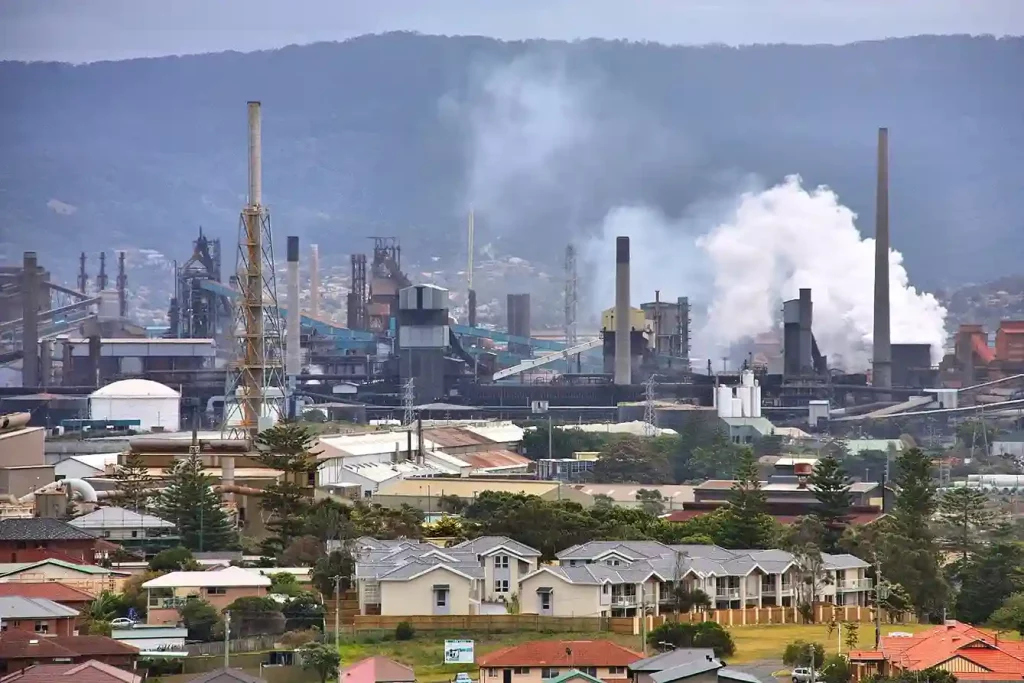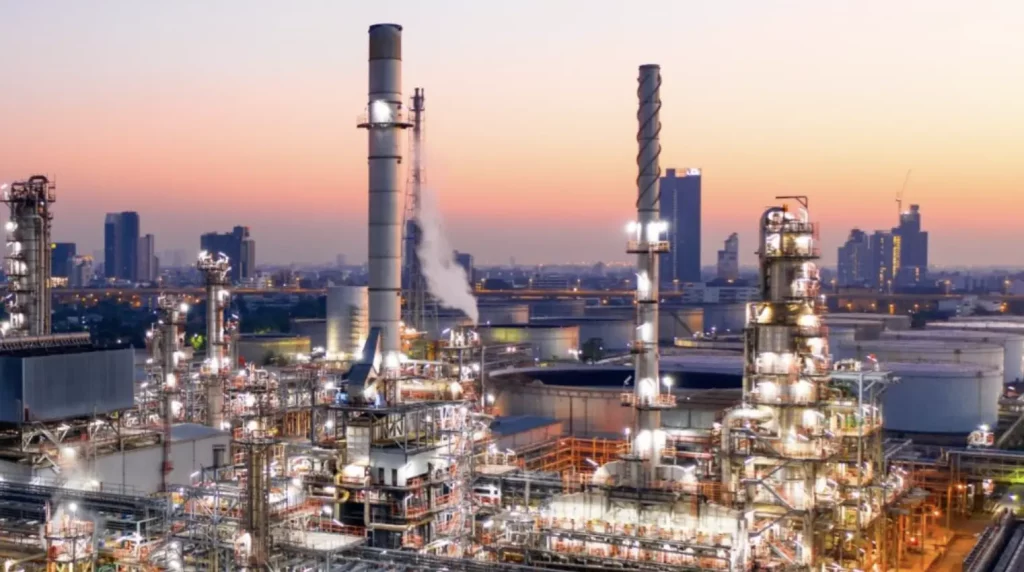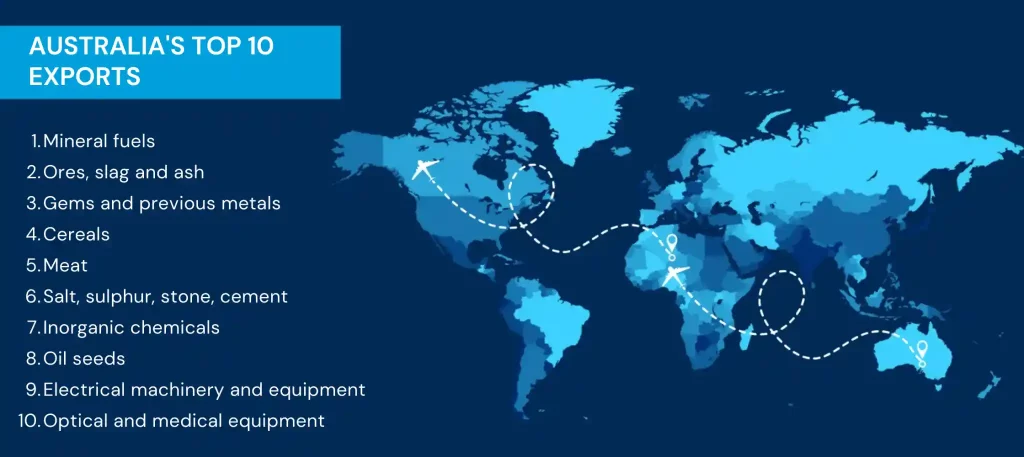Table of Contents
Did you realize that Australia stands among the nations with a substantial per capita income?
Australia’s per capita income surpasses several economically advanced countries, even outperforming the UK and the US individually.
This phenomenon significantly influences the quality of life in its regions. Notably, major Australian cities like Sydney and Perth are acknowledged for their high residential livability.
Undoubtedly, Australia’s exports play a pivotal role in driving this economic development. Now, let’s delve into the specifics for a more in-depth discussion.
Overview of Australia’s Major Export Industries

Source: Climate Scorecard
According to the Economic Complexity Index (ECI), exports of Australia can get $234 billion worth of goods, making it the 20th largest exporting country in the world.
Although most of its territory is desert, Australia relies heavily on its coastal economy to generate income and support its people. Here are the top export industries in Australia:
Exports of Australia: Biggest Exporting Industries in 2024

Source: Business Manager HR Magazine
Here is a breakdown of some of Australia’s Largest Exporting Industries in 2024, according to IBISWorld, such us:
1. Iron Ore Mining in Australia (Exports for 2024: $113.4B)
- Iron ore miners have witnessed significant price growth and modest production increases over the past 5 years.
- Iron ore revenue is projected to decrease by an estimated 16.2% in 2022-2023 due to falling iron ore prices.
2. Oil and Gas Extraction in Australia (Exports for 2024: $105.8B)
- Revenue volatility characterizes the oil and gas industry, influenced by price changes, exchange rates, production volumes, and demand.
- Australia’s natural gas production has surged over the past decade, driven by new gas field development for liquefied natural gas (LNG) facilities.
3. Coal Mining in Australia (Exports for 2024: $91.7B)
- Australia is a major coal exporter, with high-grade and economical deposits, contributing to a large share of coal mining revenue.
- Coal mining revenue is expected to grow at an annualized rate of 14.6% over the coming years.
4. Liquefied Natural Gas Production in Australia (Exports for 2024: $90.2B)
- Liquefied natural gas (LNG) production has rapidly expanded, with Australian LNG exports rising from 20.0 million tonnes in 2010-11 to 80.9 million tonnes in 2022-23.
- LNG revenue is anticipated to rise at an annualized rate of 20.7% through 2022-23.
5. Gold and Other Non-Ferrous Metal Processing in Australia (Exports for 2024: $34.9B)
- Refined gold volumes are expected to decrease in 2023-24, but surging gold prices and lithium hydroxide production have led to strong revenue growth.
- Industry revenue is projected to increase at an annualized rate of 18.1% over the next five years.
6. Grain Growing in Australia (Exports for 2024: $25.7B)
- Grain growing, producing wheat, barley, canola, and other grains and oilseeds, is export-oriented.
- Revenue is expected to grow at an annual average rate of 17.3% through 2022-23, despite challenges like volatile weather conditions.
7. Meat Processing in Australia (Exports for 2024: $19.1B)
- The Meat Processing industry has faced challenges from volatile production volumes and labor shortages due to the COVID-19 pandemic.
- Despite a period of decline, strong export demand and herd rebuilding activity have driven up domestic beef and sheep meat prices.
8. Battery Material Mining in Australia (Exports for 2024: $16.4B)
- Battery material mining revenue has soared due to increasing demand for electric vehicles, leading to a tight supply of battery materials.
- Industry revenue has grown at an annualized rate of 55.9% over the past five years, with lithium export prices skyrocketing.
9. Copper Ore Mining in Australia (Exports for 2024: $8.2B)
- Copper mining revenue is expected to increase at an annualized rate of 3.8%, driven by higher copper prices and demand growth, particularly from China.
- Australia is a major copper mining country, behind Chile, Peru, China, the Democratic Republic of Congo, and the United States.
10. Lithium and Other Non-Metallic Mineral Mining in Australia (Exports for 2024: $8.1B)
- Spodumene concentrate (lithium ore) dominates the Lithium and Other Non-Metallic Mineral Mining industry, primarily exported to China for further processing.
- Strong demand from the Chinese electric vehicle market and lithium stockpiling has led to a spike in world prices, driving growth in the industry.
Australia’s Top Export Products

Source: ICE Cargo
Australia’s major exports consist of significant commodities such as Iron Ore ($118 billion), Coal Briquettes ($54.3 billion), Petroleum Gas ($39.2 billion), Gold ($17.6 billion), and Wheat ($7.36 billion).
These goods are primarily shipped to major trading partners, with China being the leading recipient at $138 billion, followed by Japan at $47 billion, South Korea at $29.4 billion, India at $20.5 billion, and Chinese Taipei at $13.2 billion.
1. Mineral Fuels (US$158.7 billion)
- Australia is experiencing substantial growth in the international trade of petroleum gas and coal, constituting 39.6% of total Australian exports, with a 70.1% increase since 2021.
- Main players in mineral fuel exports include Woodside Petroleum and Santos.
2. Ores, Slag, and Ash (US$102.6 billion)
- Australia is among the world’s largest exporters of coal, iron ore, lead, and diamonds, with ores, slag, and ash forming around 25.6% of Australian exports.
- Iron ore exports surged by 20% in 2021, playing a crucial role in Australia’s industry and pandemic recovery.
3. Gems and Precious Metals (US$19.4 billion)
- Australia’s exports of gems and precious metals, including opals, diamonds, topaz, emerald, ruby, jade, and sapphire, exceed imports, accounting for around 4.8% of all Australian exports.
4. Cereals (US$13.8 billion)
- Cereals, including wheat, barley, oats, canola, and lupins, contribute 3.4% to Australia’s total exports.
- Australia is expected to account for a record 13.7% of global wheat exports in 2022-23.
5. Meat (US$12 billion)
- Australia’s meat industry, valued at US$12 billion, includes grass-fed beef, lamb, and live cattle and sheep exports.
- Despite a smaller supply, strong demand led to rising beef prices, while lamb exports hit a record 7% increase in 2022.
6. Salt, Sulphur, Stone, Cement (US$8.5 billion)
- This category saw the fastest-growing exports, surging by 458.3% in 2021, accounting for 2.1% of Australia’s total exports.
7. Inorganic Chemicals (US$1.8 billion)
- Australia’s chemical industry has grown, constituting around 1.8% of Australian exports.
8. Oil Seeds (US$6.1 billion)
- Oil seed exports rose significantly by 98.1% in 2022, making up 1.5% of Australia’s total exports.
- Europe is the primary destination for Aussie oil seeds, increasingly used in biofuel production.
9. Aluminium (US$5.1 billion)
- Aluminium represents around 1.3% of Australian exports.
- In March 2022, Australia banned alumina and aluminium ore exports to Russia to reduce its ability to make weapons.
10. Optical and Medical Equipment (AUD$4.6 billion)
- Machinery, including computers and aircraft parts largely exported to the United States, accounts for around 1.2% of Australian exports.
- However, Australia faced a trade deficit in machinery, especially for turbo-jets, in 2022.
Exports of Australia: Diverse Sectors Driving Economic Growth Globally
Exports of Australia excels in the global economy thanks to a diverse export portfolio, including a mining sector rich in natural resources such as iron ore, coal and gold. The substantial contribution of these resources to global manufacturing and construction helps drive Australia’s export earnings.
Australia’s agricultural sector, supported by a good climate and vast farmland, leads to the export of food items such as wheat, barley, beef, and wool, strengthening Australia’s position in world food markets.
Australian services, particularly international education and the tourism industry contribute substantially to export earnings. The natural gas and LNG sectors are also major drivers of export earnings, with Australia being a leader in the supply of LNG to Asian markets.
Exports of Australia manufactured goods, including machinery, vehicles, and medical equipment, add to the diversification of the Australian economy, creating a strong export landscape. By seeking to diversify export markets, Australia is demonstrating its ability to adapt to changes in global demand, maintaining the country’s economic stability.








